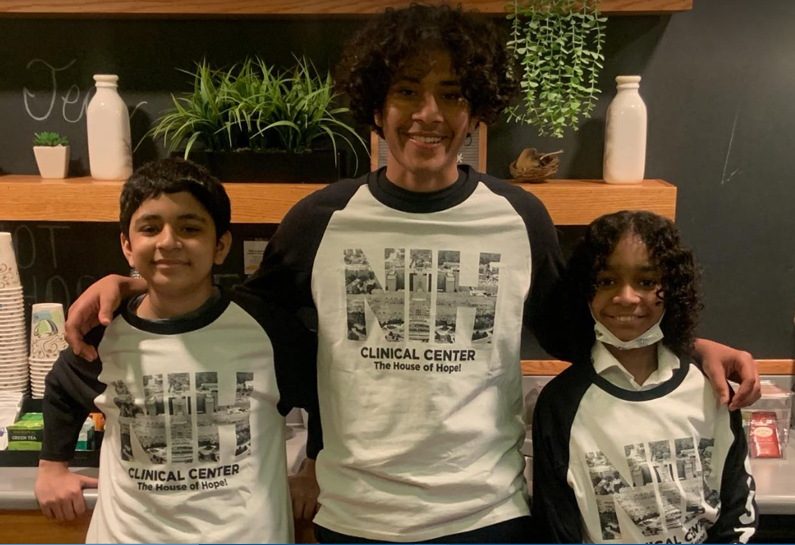Participating in a clinical trial, the seventh-grader received a life-saving bone marrow transplant, shedding light on a promising new preoperative conditioning treatment

Since birth, seventh-grader Elyas Khandwalla has lived with sickle cell and beta thalassemia disease, often experiencing extreme pain and fatigue, among other serious health complications.
Caused by a single genetic mutation, the inherited blood disorder creates brittle, misshapen red blood cells. The condition is compounded by low levels of the oxygen-carrying blood protein beta globulin hemoglobin. Both deprive the body of oxygen and can cause stroke, arterial inflammation, organ failure, and premature death.
But thanks to a life-saving bone marrow transplant (BMT) at the NIH Clinical Center, Elyas is now free of his disease.
"I'm happy to be cured," the cherubic tween says, speaking by video chat from his home in Mombasa, Kenya, surrounded by his mother Zuleikha, father Nadeem, and older brother Mohammedali. "Everything is going well."
Our body's blood cells are produced from stem cells in our bone marrow. To cure sickle cell disease, defective marrow must be replaced with healthy marrow tissue free of the disease-causing genetic mutation.
Elyas was fortunate to find a donor match in his older brother and underwent the procedure at the NIH Clinical Center while participating in a clinical research trial.
The trial—led by Drs. Matthew Hsieh and John Tisdale with the Cellular and Molecular Therapeutics Branch of the National Heart Lung and Blood Institute—is testing the effectiveness of a promising new BMT preoperative conditioning treatment that leverages the JSP191 antibody.
Most bone marrow transplant recipients receive high-dose radiation and/or chemotherapy to remove all traces of defective bone marrow, prior to receiving donor stem cells. Elyas received the JSP191 antibody, developed by Jasper Therapeutics, which was anticipated to make the combination of another antibody and low dose radiation more effective in removing his own marrow cells. The combination carries far milder side effects than high or full doses of chemotherapy or radiation.
Elyas's parents say both the treatment and BMT were a success. Elyas, who in his free time loves to play soccer and computer games and hopes to become a doctor one day, is now cured of sickle cell and beta thalassemia. He says he feels "more energized" and no longer experiences extreme pain in his pelvis, legs, and spine.
"We had a team, and they were the most amazing team we could ever ask for," Elyas's mother, Zuleikha, says. "They're always there. Even if you have a thousand questions, they will still answer all your questions. They try to make you feel as comfortable as possible."
She said she learned about NIH Clinical Center trials through a friend she met on Facebook, whose own son, Caesar Sant, underwent a bone marrow transplant at the Clinical Center to cure his sickle cell disease in 2021.
Elyas's parents said their search for a cure became more urgent as his platelet levels began to fall and his liver enzyme readings began to climb, foreshadowing potential organ injury.
Nadeem, who worked in IT, and Zuleikha, who worked as the chief accountant of a law firm, said they both quit their jobs and sold most of their possessions, including the family car, in order to move to the United States for Elyas's treatment.
In total, they spent a year at The Children's Inn and 40 days at the NIH Clinical Center. Zuleikha says her family found a home away from home. "They supported us in every way. They were amazing."
Children's Inn staff provided tutors and even introduced Mohammedali, a high school junior and avid swimmer, to the local YMCA, where the aspiring lawyer was able to join a swim team, socialize with peers, and volunteer with the center's swim program.
"They do so much," Zuleikha said of the inn's staff and of the families they met there. "There's always someone to talk to, someone to hug, someone to make you feel like we are here for you … . We met so many families that became family that we still keep in touch."
As their story suggests, the Khandwalla family are willing to sacrifice everything for one another. Mohammedali, who made the life-saving bone marrow donation for his younger brother, described the procedure as the "hardest five hours of my life …" "But at least I [got to] cure my brother."
During medical screenings prior to donating marrow to his younger brother, Mohammedali was diagnosed with a congenital heart defect known aortic coarctation, which is a narrowing of the aorta.
"We would never have known had he not become a donor," Nadeem says. "We are now in search of a hospital or trial that can correct his condition."
- Sean Markey

